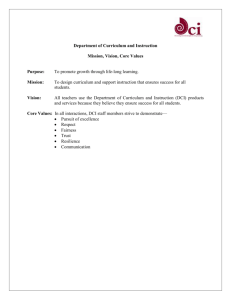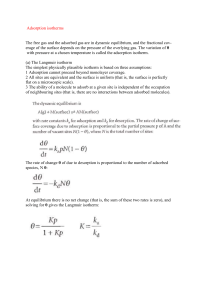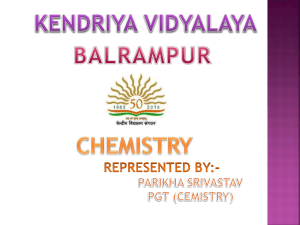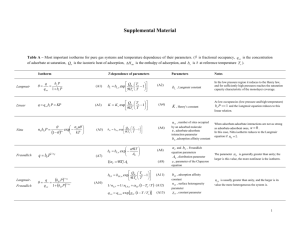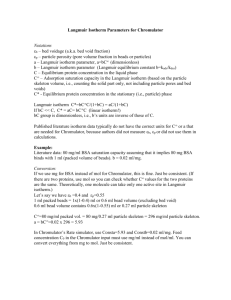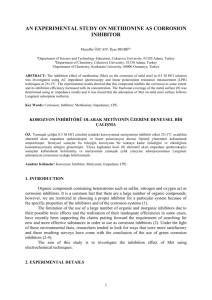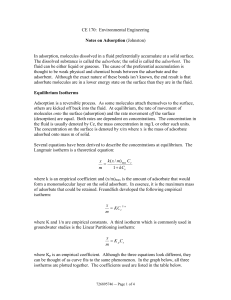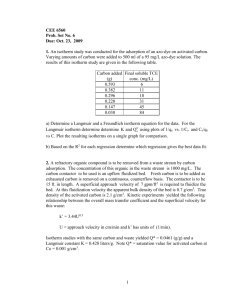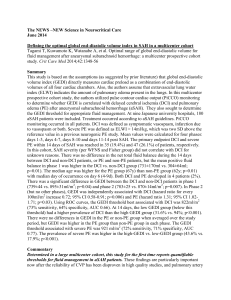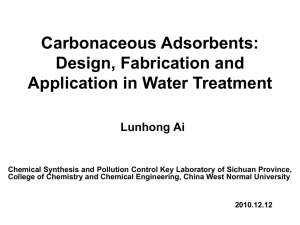Lecture 19
advertisement
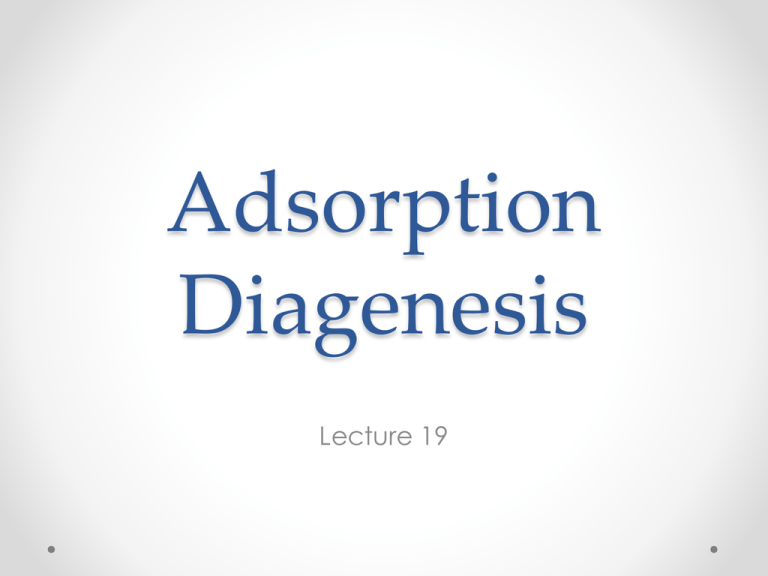
Adsorption Diagenesis Lecture 19 Adsorption • Physical o attachment of atom or molecule to a surface through van der Waals or intermolecular forces. o Weak: ∆Had ≈ 4-12 kJ/mol • Chemical o formation of new chemical bond between adsorbed species and atoms on surface o Stronger: ∆Had >40 kJ/mol Adsorption and Surface Free Energy • Adsorption changes the nature of the surface and therefore the surface free energy. • We can express the surface free energy as: ds = -å i ni,s d mi = -å G i d mi A i • where we define Γi as the Gibbs Absorption Density: moles of i absorbed on the surface per unit area. Equilibrium Adsorption • Consider adsorption of species M on surface S: M + S = MS • Let the fraction of surface sites occupied by M be θM. • Fraction of free sites is then 1 - θM. • Assuming elementary reactions, rate of adsorption is: - dM = k+ [M ](1- Q M ) dt dQ = k- Q M • Rate of desorption is dt • At equilibrium k+ [M ](1- QM ) = k-QM - • and QM = k+ / k- [M ] K ad [M ] = 1+ k+ / k- [M ] 1+ K ad [M ] Langmuir Isotherm QM = K ad [M ] 1+ K ad [M ] • is known as the Langmuir Isotherm o named for Irving Langmuir, who worked for GE. • We can also express this in terms of the adsorption density: K ad [M ] max GM = GM 1+ K ad [M ] • At large concentration then G M = G max M Freundlich Isotherm K ad [M ] QM = 1+ K ad [M ] • At low concentration, QM @ K ad [M ] • In other words, fraction of sites occupied by M is proportional to concentration. • This is known as the Freundlich Isotherm. • We’ll return to this in the Red curve shows adsorption of Sr on next chapter. FeOOH calculated from Langmuir Isotherm. Inset shows linear Freunlich behavior at low concentration. Diagenesis Diagenesis is the transformation of a sediment into a sedimentary rock. Physical processes involve compaction and expulsion of water as the sediment is buried. We’ll briefly consider some of the chemical processes that accompany this. • Consider a sedimentary layer ‘A’ being buried as sediment accumulates above it. • We can chose a reference frame fixed to the layer, or to the sediment-water interface. In the latter case, the layer will appear to move downward with time. • Change in concentration at some fixed depth x is then: dCi æ ¶Ci ö æ ¶Ci ö -w ç çè ÷ø = ÷ø è ¶t x dt ¶x t • First term on the right is any changes in concentration within layer, second term is the concentration gradient times the burial rate, ω. • We can use this equation to change reference frames. Steady-State Case • • This is the case where: dCi æ ¶Ci ö æ ¶Ci ö = w çè ÷ çè ÷ =0 ¶t ø x dt ¶x ø t Solving, we have: dCi æ ¶C ö =wç i÷ è ¶x ø t dt • • In this case, the concentration in the sediment at the surface is constant, but diagenetic changes result in decrease in concentration with time. But concentration at a fixed depth is constant. The diagenetic changes impose a concentration gradient. No diagenesis • This is the case where • so that dCi =0 dt æ ¶Ci ö æ ¶Ci ö = w çè ÷ çè ÷ ¶t ø x ¶x ø t • Change in concentration at some fixed depth is the burial rate times the gradient. Diagenetic Process • Sediment consists of particles plus ‘pore water’. If porosity is ϕ then fraction of particles is 1 - ϕ. • As weight of sediment accumulating above increases, water tends to be expelled - resulting in upward velocity of pore fluid. • In addition, dissolution and cementation (precipitation) can change porosity. • Due to compaction, rate of burial will not be equal to sedimentation rate. Fluxes and Bioturbation • • Now imagine a layer of sediment of thickness dx. There are fluxes into and out of this layer due to: o o o • • Water advection Chemical diffusion Bioturbation Advective Flux is simply J = vCi We can treat the biodiffusive flux the same as chemical diffusion: æ ¶C ö J b = -DB ç è ¶x ÷ø t • • A difference is that the biodiffusive flux is likely to be a function of depth since most animals live near the surface (and O2 generally decreases with depth). For biodiffusion, Fick’s Second Law becomes: æ ¶C ö ì ¶(DB ¶C / ¶x)) ü ý çè ÷ø = í ¶t x î ¶x þt Diffusion and Porosity • Diffusion is so much faster through the pore water than through solids, the latter can be effectively ignored. • Thus we can view the ‘molecular flux’ - the chemical one we have already discussed, as reduced to that occurring through pores: æ ¶C ö J M = -f DM ç è ¶x ÷ø • Fick’s Second Law becomes æ ¶Ci ö 1 ¶(¶f D(¶Ci / ¶x)t çè ÷ø = ¶t i f ¶x Diagenetic Equation • Thinking again about our layer, conservation of mass dictates that the concentration of i will change if the fluxes of i in are different than the fluxes out: ¶å J i dCi ¶F ==- i dt ¶x ¶x o F is the sum of the three fluxes • Concentration may also occur as a result of reactions involving i, Ri occurring within the layer. • Overall then dCi ¶Fi =+ å Ri dt ¶x Diagenetic Equation • • • dCi ¶F = - i + å Ri dt ¶x This describes the changes in a reference frame fixed to the layer. We transform it to a reference frame fixed to the sediment-water interface by including the burial term: dCi ¶C æ ¶F ö = - ç i ÷ - w i + å Ri è ¶x ø t dt ¶x We can consider burial to also be a flux. Combining the burial and flux terms, we have ¶Fi æ ¶Ci ö = + å Ri çè ÷ ¶t ø x ¶x • Berner named this the Diagenetic Equation. Example: Reduction of Sulfate • Sulfate is abundant in seawater and will be reduced by bacteria to sulfide once O2 is exhausted to metabolize organic matter. We assume the (only) reaction is: 2CH2O + SO42- = H2S + 2HCO3• Assume the rate of reaction depends of availability of organic matter: 1 d[CH 2O] - 2 • Assuming steady-state • Then • Integrating: dt = k[CH 2O] dCi æ ¶C ö =wç i÷ è ¶x ø t dt æ ¶[CH 2O] ö -k[CH 2O] = w ç è ¶x ÷ø t [CH 2O](x) = [CH 2O]˚e- kx/w Sulfate in Saanich Inlet • Saanich Inlet is an anoxic fjord in British Columbia. • Since the consumption of sulfate relates to the consumption of organic matter: d[SO42- ] k[CH 2O] - kx/w = e dt 2 • The sulfate is a dissolved species, so we need to consider diffusion. Remembering the steady state assumption, then: æ ¶2 [SO42- ] ö æ ¶[SO42- ] ö k[CH 2O]o - kx/w fDç -w ç e =0 2 ÷ ÷ 2 è ¶x ø è ¶x ø t • Integrating w 2 [CH 2O]˚ kx/w [SO ] = (e -1) 2(w 2 + kD)f 24
